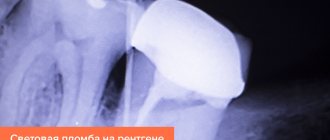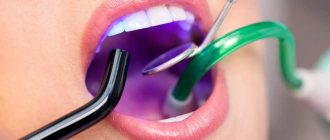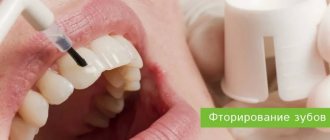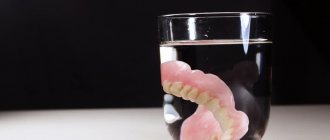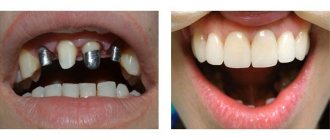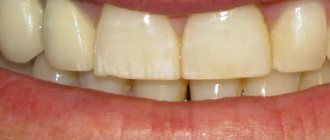Cleaning dental canals is one of the most painstaking, and sometimes even precious, dental procedures, the quality of which determines the success of the entire treatment. The main problem is that the dentist is working with the hidden part of the tooth. These channels are very difficult to get to and cannot be seen with the naked eye. But whether the therapy will be successful often depends on the accuracy with which the number of dental canals is determined - it may vary from person to person. In addition, the doctor must be aware of their exact size and length. And an x-ray of the tooth will help him with this.
Rules for caring for teeth after filling
Types of fillings and care features
In the first days after filling
If the filling is temporary
Why does a tooth hurt after installing a filling?
Why is a preventive examination necessary?
A filling cannot replace tooth enamel. No matter how similar it may be in appearance, in terms of its characteristics and properties the filling is significantly inferior to native enamel. First of all, because it has a service life. A filling can protect a tooth for about 3 to 5 years, then it will have to be replaced. With good care and proper installation, the filling can last longer than expected. We'll tell you how to properly care for your teeth after filling, so you don't have to run to the dentist ahead of time.
Recommendations after installing other fillings
Chemical-curing fillings are cheaper than light-curing fillings, so they are still widely used in dental practice. It takes time to completely harden, so you will have to go a couple of hours without food.
Cement fillings are used very rarely today because they are inferior to other materials in strength, are difficult to grind, fall out quickly, and the color of the material is not easy to match to the natural shade of the teeth. Perhaps the only advantage of cement fillings is their low price, so they can still be used in pediatric dentistry as a budget alternative to more expensive options.
It is not recommended to eat or drink immediately after installing a cement filling. The exact time of abstinence from food and drink will be announced by the doctor. If anesthesia was used during the treatment of caries, then, regardless of the material and type of filling, you must refrain from eating for a couple of hours until the effect of the anesthetic injection wears off. This recommendation is due to the fact that the sensitivity of the oral cavity is reduced and during chewing you can damage the cheeks or tongue.
To further monitor the condition of fillings and the oral cavity, it is recommended to visit a dentist once every six months for a preventive examination. It is recommended to care for filled teeth in the same way as for ordinary ones - brush twice a day with toothpaste and a brush, use additional hygiene products (rinses, floss), regularly visit a hygienist and carry out professional hygiene.
Types of fillings and care features
Different fillings have their own characteristics in terms of wearing time, hardening, etc. For example, light fillings harden under the influence of a halogen lamp in a matter of seconds, so you can eat or drink water almost immediately after the procedure. However, you should not remove all restrictions: complete hardening of the filling occurs in two days. Composite fillings are very sensitive to alcohol at first, so you should avoid alcohol and alcohol-containing rinses, as the filling may soften.
After treatment, we recommend that you check with your dentist about the type of filling he placed and after what time you can eat.
What determines whether you can or cannot eat after dental treatment?
Whether you can eat immediately after leaving the doctor’s office or whether you need to wait depends on what kind of filling material was used.
A few decades ago there was no such choice of materials, and dentists forbade eating and drinking for 1.5 hours after any treatment procedure. This time was necessary for the filling to completely harden. If the patient violated the doctor’s recommendation, eating ahead of time could lead to deformation of the filling. In addition, the material did not have time to hermetically close the cavity; particles of water and food got into the microcracks, which could lead to the re-development of the carious process under the filling, reducing its service life. Today, the choice of filling materials for dental treatment has expanded significantly. In particular, there are those that harden almost instantly, and their quality and strength are not affected by the consumption of food or drinks. The dentist gives each patient individual recommendations on how much he should not eat (an hour, two, and sometimes he can eat right away). If a person wants to have the opportunity to eat after caries treatment, he must tell the doctor about this before starting dental procedures.
In the first days after filling
The filling easily absorbs coloring pigments, so you should adjust your diet in the first week.
- Avoid coloring foods (coffee, tea, bright berries, beets, red wine, foods with food dyes).
- Avoid sticky and hard foods (nuts, toffee, kozinak). Hard products can deform the surface of the filling, while viscous products, due to their sticky consistency, contribute to the development of caries.
- Food should not be too hot or cold. The seal must be properly secured. Temperature changes, on the contrary, will interfere with a tight seal.
- It is better to chew on the opposite side.
What about smoking?
It is not advisable to smoke immediately after the procedure, since tobacco smoke affects the adhesion of the filling material to the tooth tissue. In addition, smoking can cause the filling to change color and be very different from the enamel.
Features of nutrition during the rehabilitation period
It is advisable that the diet after dental implantation include:
- Calcium-rich foods. These include milk, kefir, cottage cheese, sour cream, and natural yogurt. This macronutrient helps bone tissue grow faster and stabilize the implant.
- Foods high in vitamin D3 and Omega-3. These include cod liver, herring, mackerel, salmon, and sardines. These substances promote better absorption of calcium, increase immunity, and improve metabolic processes.
- Porridge, vegetables, fruits. Enrich the diet with essential vitamins and minerals.
Also, the daily menu should include meat and fish dishes. If solid food is not indicated, you should prepare minced meat dishes by steaming them so that the consistency is as tender as possible.
If the filling is temporary
A temporary filling is usually placed for 1 to 2 weeks, so it is not as durable as a permanent one. You don’t need to be afraid to brush your teeth, but you shouldn’t put too much pressure on the tooth while brushing. It is also recommended to avoid chewy foods and chew on the opposite side.
Hygiene after tooth filling
In general, oral care after a filling is installed is no different from usual.
| Brush your teeth twice a day for 2 – 3 minutes. It is better to use a brush with soft bristles that does not scratch the enamel and the surface of the filling. |
| Try not to brush your teeth with abrasive whitening toothpastes. |
| As an addition to daily care, we recommend using an irrigator. It cleans hard-to-reach places from food debris without harming enamel, gums and fillings. |
Stages of cleaning dental canals
To properly clean the dental canals, the dentist must carry out the following necessary manipulations (step by step):
- Applying a protective lining to the area adjacent to the affected tooth. First, injection anesthesia is performed (or dental treatment is offered during sleep), and then the doctor places a protective pad around the tooth in the form of a thin sheet of rubber. Since the main goal pursued in the treatment of affected dental canals is to cleanse them of bacteria from the inside, the protective overlay reliably protects the tooth from saliva. After all, saliva contains many bacteria, and if the affected tooth is not isolated, then new colonies of bacteria will again rush into the freshly cleaned dental canals.
- Providing access to the dental nerve . This is why the doctor drills a hole in the tooth. There is no other way to reach the area in need of cleansing. Therefore, the doctor creates this access himself in order to begin treatment as soon as possible. For this, a well-known dental bur is used. With its help, the specialist enters the pulp chamber of the diseased tooth through a tiny hole.
- Cleaning the cavity of a diseased tooth . To clean the inner surface of the tooth cavity, the dentist uses special files—the so-called tools that look like long needles. In fact, these are rather micropiles that perform a similar function. The doctor performs manipulations with the canals, operating with several files of different diameters - from smaller to larger. During the cleaning process, he simultaneously rinses the tooth cavity in order to thoroughly clean the tooth canal along its entire length.
- Closing the dental canal with filling material.
Soft food
If you answer the question of how long after tooth extraction you can start eating, then you can eat food either on the day of the operation or on the next day. However, it should be remembered that food must be soft at first. In order for the healing period to pass comfortably and quickly, experts recommend consuming soups, liquid cereals, purees, as well as foods enriched with vitamins in the first 2-3 days. The diet should include fruits, but preference should be given only to those with soft flesh. These are peaches, bananas, seedless berries, melon, apricots and persimmons. But it is better to refrain from citrus fruits such as oranges, lemons, kiwi, pomegranate and others. The large amount of acid contained in them has a negative effect on irritated gums.
What should you eat to keep your teeth as healthy as possible?
Give preference to raw vegetables and hard fruits such as carrots, cabbage, radishes, apples, and bell peppers. They train your gums and cleanse your teeth of plaque.
For dental and oral health in general, all foods that contain significant amounts of calcium, fluorine, zinc, iron, magnesium, phosphorus, vitamins A, K, D, B6, B9, B12, E and C, protein, arginine, casein and phosphates, Omega-3 polyunsaturated fatty acids, antioxidants. It is advisable to regularly consume greens (for example, dill, celery, parsley, cilantro), leafy vegetables (lettuce, spinach and others), nuts, seeds, whole grains, chicken eggs, garlic, ginger, cheese, cottage cheese, yogurt, white meat , lean beef, fish, shrimp, legumes (soybeans, lentils, beans), mushrooms, buckwheat, oats, raisins, wholemeal and bran bread.
You can moderately consume natural sweets, for example, honey (it is better to eat it with honeycombs, chewing which improves the condition of teeth and gums). You should also eat dried fruits. They are rich in vitamins, contain natural (unrefined) saccharides, and chewing them is good for your teeth. Fresh berries and fruits that are good for teeth include rose hips, strawberries, grapes, cherries, currants, peaches, plums, and pineapples. Unsweetened green tea, especially consumed after meals, is also beneficial for the oral cavity, as it contains polyphenols and fluorides, destroys many pathogens, inhibits the growth of bacteria, neutralizes acid, prevents tooth loss and reduces gum inflammation.
Plant products containing anthocyanins (for example, cranberries, blueberries, raspberries, red cabbage, eggplant, black rice) prevent the appearance and development of pathogens on teeth. Fermented milk products, due to the content of probiotics in them, prevent the proliferation of pathogens in the oral cavity.
We can conclude: maintaining dental health by eating right is not difficult. Unfortunately, many people from childhood ate the wrong things and the wrong things, which caused various dental problems. If your teeth are significantly damaged, partially or completely lost, prosthetics made using one of the advanced techniques will return you to the ability to eat without difficulty or inconvenience.
Amalgam filling
Amalgam is an alloy of silver or copper with various metals, each of which performs its own function:
- Silver gives strength and antiseptic properties.
- Tin regulates the hardening process.
- Copper increases the strength of the alloy.
- Zinc prevents oxidation.
- Mercury is needed to obtain a plastic, quickly hardening mixture.
Amalgam fillings have both advantages and disadvantages. They are durable and affordable, but have low aesthetic properties (characteristic metallic luster, change in enamel color). These fillings are placed primarily on the back teeth (molars).
Metal fillings have a long hardening period, so dentists recommend that patients refrain from eating for 4-5 hours after the filling procedure. Do not consume foods that can cause metal oxidation. Since the dental alloy is insensitive to moisture, there are no restrictions on fluid intake.
What is a light seal?
The photopolymer composite material that the dentist uses consists of a mixture of resins, silanes and filler.
It hardens when exposed to ultraviolet radiation, so when filling a tooth, the doctor uses a special lamp that creates waves with a length of 450 Nm in the blue spectrum. For a high-quality result, he applies the composite material layer by layer, exposing each layer to light. At this stage, primary polymerization occurs. Then, within 24 hours, the chemical bonds stabilize and the filling finally hardens. In this regard, the doctor gives certain recommendations, compliance with which guarantees the durability of the material - the filling lasts 5 years or more.
